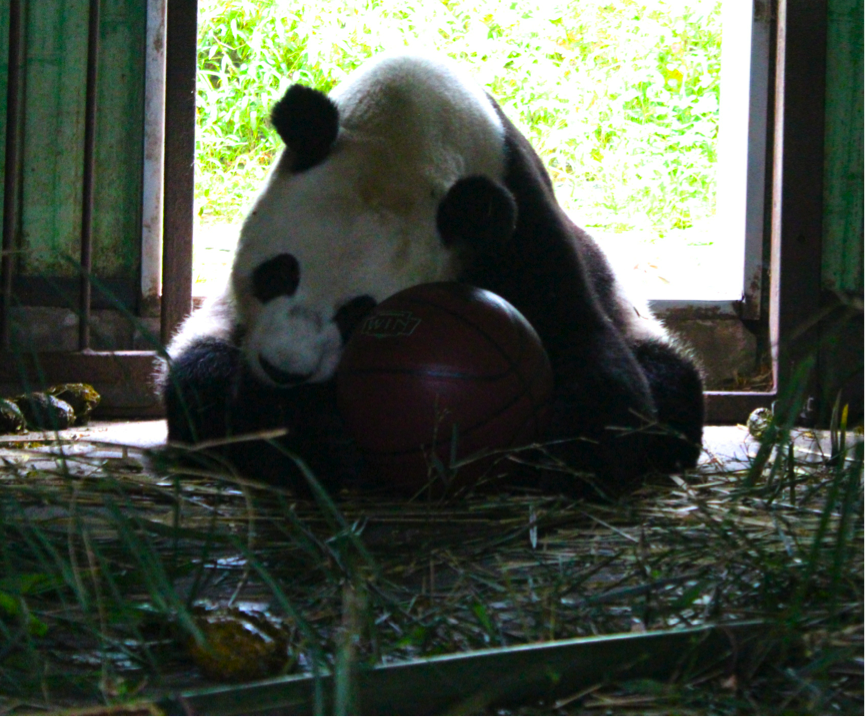
Photo from gawker.com article on the world’s most expensive tea – panda poop tea! (click the image to go to the article)
This fact is directly relevant to Meghan’s recent fund-raising campaign to analyze fecal samples from the pandas in her study . . .
5. Pandas’ can produce 48-62 pounds of waste each day
That’s 21-28kg for the people back in my homeland. I bet I could name one of my best friends who could possibly give pandas a run for their money. Never the less this is a mighty feat for any animal that’s not an elephant, which can produce anywhere up to 300 pounds of waste in one day.
Most of what is consumed by the panda comes straight back out the other end. Their digestive system is short, just like you would expect to find in a carnivore. This makes it extremely difficult for the giant panda to digest and up take the nutrients of bamboo. If you’ve ever seen a pandas ‘waste product’ you will know how easy it is to tell that they have eaten bamboo. Chunks of bamboo and bamboo leaves are clearly visible and sometimes the ‘waste product’ just falls apart, as if the separate pieces of bamboo were just torn off the stem.
Panda poo can potentially bring much more to society that 62 pounds of waste. The bacteria found in the intestines and poo of the giant panda might be able to be used as a model to convert grass or bamboo into biofuels. The short digestive system of the panda makes it extremely difficult to gain any nutrients from their predominantly herbivorous diet. Animals like cows and sheep have digestives systems specifically designed for their diet using a 4-chambered stomach to gradually remove the energy from grass. Therefore the bacteria in the pandas’ intestines need to be potent to be able to break down plant matter much more quickly. This bacteria could be used to make biofuel production much more efficient and cheaper. If you wanted to read more about panda poo and the potential for biofuel production I found this article explains it well.
This is merely one example of why conserving species, as well as biodiversity is so important in a modern world.
So those are my five favourite fun facts about the giant panda. There are many many more out there, but I found these extremely thought provoking. I find this animal so unique and not just because of their characteristics or morphology, but because of their ability to defy stereotypes and evolve such great adaptations. They are a true example of how there’s always more to know when it comes to science.
– Grace


Unless there is another Yao Yuan that I don’t know about, Yao Yuan is a female, she is wild born and was rescued a few months after Gao Gao. She was Gao Gao’s childhood friend.
Danielle,
Thanks for pointing this out – she is a girl! (see my earlier “Panda of the Week posts). I think Grace probably mistyped but I’ll have to ask her for clarification.
Thanks for pointing this out!
Meg
Thanks Meg!
Meg, I really enjoyed all of your wonderful posts. Since you have been at BaiYunFeng recently, I would like to ask Tai Shan’s condition. Just a Tai fan and want to know more about him. Thanks
Jenny,
He appears to be doing great! They’re even attempting to breed him now (unfortunately with no success yet but he’s only 8 this year so may still show success). I try to check in on him at the “international bear” area and there are always tons of crowds! He’s a star in the US and abroad! I’ll try to get some video or something posted for you. Thanks for reading.
I believe Tai Shan lives just across the base hospital at Bifengxia and not in Overseas Pandas area. And Yao Yuan was his neighbor. I could be wrong; I was there in September and he may have been moved. The last I saw via some photos by November visitors is that female Lin Ping of Thailand and male Fu Wa who will be transferred to Malaysia in 2014 currently live in Villa 5 at Overseas Pandas.